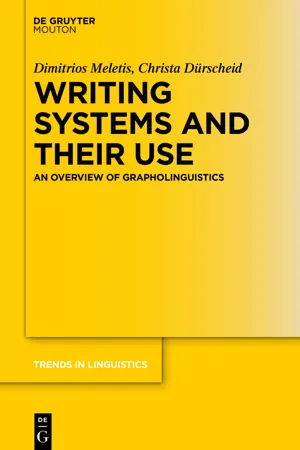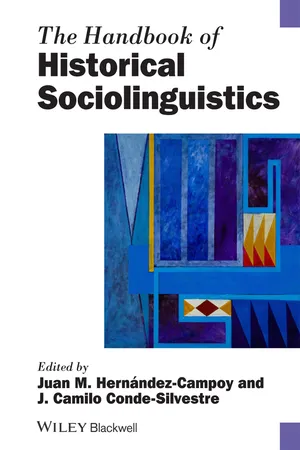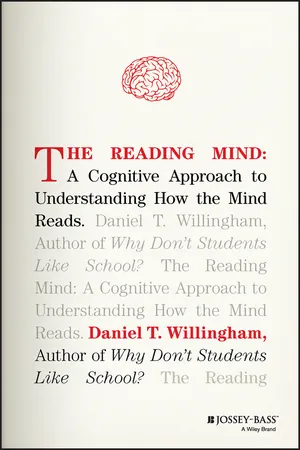Languages & Linguistics
Orthographic Features
Orthographic features refer to the visual representation of language through writing systems. This includes aspects such as spelling, punctuation, and capitalization. Understanding orthographic features is important for analyzing and comparing different writing systems, as well as for studying the impact of orthography on language processing and literacy development.
Written by Perlego with AI-assistance
Related key terms
Related key terms
1 of 4
Related key terms
1 of 3
4 Key excerpts on "Orthographic Features"
- eBook - ePub
Writing Systems and Their Use
An Overview of Grapholinguistics
- Dimitrios Meletis, Christa Dürscheid(Authors)
- 2022(Publication Date)
- De Gruyter Mouton(Publisher)
Nerius (2007 , 2020). The features he focuses on are based on an investigation of German orthography; therefore, they may be generalised and applied to other orthographies only with caution. Nonetheless, as we will see, given their broad nature, the majority of them do also apply – to varying degrees – to orthographies of other, including non-alphabetical, writing systems. Orthographies are commonly:- externally codified, i.e., authorities of linguistic policy (such as councils, language academies, publishers of dictionaries) decide on and codify orthographic rules and correct spellings.
-
socially binding, i.e., users commonly adhere to orthographic norms and simultaneously perceive them to be binding while ascribing to them the feature of being binding. This bindingness also leads to social sanctions of deviance from the norm.
- characterised by limited variability, i.e., in most cases there will be one unambiguously correct way of spelling something.
- static, or, in other words, only changeable in the course of orthography reforms.
The first described feature of orthographies is that they are (1) external and codified standardisations. While ‘codified’, as already mentioned above, means that orthographic norms are systematically laid down in written form as rules, ‘external’ refers to two aspects: firstly, orthographic rules are commonly prescribed by outside regulators rather than being internal norms (or better: conventions) that users mainly arrive at through their own implicit graphematic analysis of the writing system (see also the next section). Secondly, ‘external’ also refers to these very outside regulators: behind most orthographies, there stand authorities who have the power to either decide on the norms or codify them – or both. For the pluricentric German, for example, both of these tasks are carried out by the Council for German Orthography (German Rat für deutsche Rechtschreibung) in which 41 members from seven countries and regions decide on orthographic regulations and, in the next step, codify them by means of a rulebook, the so-called Amtliche Regelung ‘official regulation’. While the Amtliche Regelung codifies general rules of the orthography as well as distinct spellings in an additional word list (the last version of which includes roughly 12,000 entries), dictionaries – such as the Duden or the Wahrig – which are not associated with the Council for German Orthography - eBook - ePub
- Juan Manuel Hernández-Campoy, Juan Camilo Conde-Silvestre, Juan Manuel Hernández-Campoy, Juan Camilo Conde-Silvestre(Authors)
- 2012(Publication Date)
- Wiley-Blackwell(Publisher)
s present in a text, and thus amenable to investigation, as well as their distribution, seem to depend on the extra-linguistic factors involved, as the following sections will show. The typology and distribution of orthographic variables can also differ across languages.In fact, there has only recently been a growing recognition of the usefulness of orthographic variation for linguistic, especially sociolinguistic, investigations. But authors examining the distribution of orthographic variants according to extra-linguistic factors rarely use the term orthographic variable , and even those who do use it do not offer a clear-cut definition of it. For example, Stenroos (2004 and 2006) investigated the realizations of the variables (th) and (gh) in Middle English texts, and Hernández-Campoy and Conde-Silvestre (1999) examined the variables (sh), (wh), and (u) in Early Modern English documents, referring to the word-initial, word-final, and occasionally word-medial orthographic variants found in a number of lexemes. These correspond to orthographic realizations of particular phonemes, or, in terms of placement, the onsets, codas, and nuclei of the syllables which they represent. For instance, the variable (wh) may refer to the Middle English spellings <wh>, <qw>, <qu> in the word WHICH, presumably pronounced as the labio-velar semivowel /w/. Thus the term orthographic variable is not equivalent to grapheme , as different graphemes (including their allographs) or combinations of graphemes can be variants of the same variable. Neither is it necessarily directly related to the phoneme, though in the example given above it is compatible with that unit of the phonological system. Nevertheless, an orthographic variable may also comprise orthographic realizations of morphological categories, such as: the preterite and past participle ending {-ed} (Oldireva-Gustaffson 2002, Sairio 2009: 226–61); whole lexical items, for instance (much), (such), and (which) in former stages of English (Taavitsainen 2004, Conde-Silvestre and Hernández-Campoy 2004, Hernández-Campoy and Conde-Silvestre 2005). It may even operate at the level above the word boundary, for example contracted vs. non-contracted forms of auxiliary verbs such as don’t and do not - eBook - ePub
Visual Word Recognition Volume 2
Meaning and Context, Individuals and Development
- James Adelman(Author)
- 2012(Publication Date)
- Psychology Press(Publisher)
The goal of this chapter was to analyze and review what is currently understood about orthographic learning. We sought to discuss the evidence underlying how children move from a slow, laborious word identification process to effortless and instantaneous word recognition ability. Ironically, to date, our best understanding of this process suggests that, in many ways, it is the participation in the initial stages of word identification that enables a child to become a skilled reader. It is the effortful decoding that characterizes early reading, which brings about the reader’s attunement to the regularities of written language and provides the opportunity to secure detailed word-specific orthographic information in memory and ultimately to read words by sight. This ‘self-teaching’ mechanism is powerful and appears to become activated quickly and persist long term regardless of whether words are read silently or aloud, and with the support of context or in its absence. In fact, it is the multitude of different types of reading experiences that allows the reader to continue to develop and refine the print lexicon throughout adulthood.We have also attempted to contextualize the discussion of orthographic learning by highlighting the underlying role that language-specific factors play in determining orthographic learning. Although orthography is a universal constituent of word recognition, readers of deep orthographies may be more dependent on orthographic information and the ability to develop well-specified orthographic representations than readers of shallow orthographies. Nevertheless, the study of the differences in orthographic learning between languages is in its infancy and in this review we have discussed only some of the differences in orthographic learning across the alphabetic - eBook - ePub
The Reading Mind
A Cognitive Approach to Understanding How the Mind Reads
- Daniel T. Willingham(Author)
- 2017(Publication Date)
- Jossey-Bass(Publisher)
and how they look. But what about meaning? Obviously vocabulary is important to reading, and we'll examine the process of learning new word meanings in the next chapter.Summary and Implications
Summary
- Experienced readers have distinct representations for three aspects of each word: the sound, the spelling, and the meaning. These representations are distinct, but tightly linked, so that thinking of one makes it easy to think of the other two.
- Experienced readers can access meaning from print either by sounding words out or by matching the spelling on the page to an orthographic representation in the mind.
- Experienced readers typically use both pathways to word meaning simultaneously as they read.
- Orthographic representations of words help you identify letters, even as letter identification helps you know which word you're reading; the two processes are reciprocal.
- When readers can read by spelling as well as by sound, decoding requires less attention, which leaves more attention available for the work of comprehension.
- Spelling representations develop through reading.
Implications
- It seems at least plausible that you would use the same orthographic representations to read and to write. Thus we might expect that instruction in the spelling of words would help orthographic representations develop. Indeed evidence shows that such instruction does improve reading.34 So that's a reason to include spelling instruction in schools, even though we all use word processors with spell‐checkers.
- If orthographic representations develop through self‐teaching, then they won't develop as well if children don't get proper feedback. That is, if a child sees “bear” but sounds it out as beer, that's going to slow progress in developing the right orthographic representations. That, in turn, suggests that this aspect of reading practice will be more effective if students read aloud, rather than silently, at least until they can sound words out pretty reliably.35,36 The quality of feedback they receive matters too—gains are larger when an adult provides feedback than when a peer does.37
Index pages curate the most relevant extracts from our library of academic textbooks. They’ve been created using an in-house natural language model (NLM), each adding context and meaning to key research topics.
Explore more topic indexes
Explore more topic indexes
1 of 6
Explore more topic indexes
1 of 4



